Dodd-Frank Act Stress Test 2015: Supervisory Stress Test Methodology and Results
- Supervisory Scenarios
- Supervisory Stress Test Framework and Model Methodology
- Supervisory Stress Test Results
Supervisory Scenarios
On October 23, 2014, the Federal Reserve released the three supervisory scenarios: baseline, adverse, and severely adverse.9 This section describes the adverse and severely adverse scenarios that were used for the projections contained in this report. These scenarios were developed using the approach described in the Board's Policy Statement on the Scenario Design Framework for Stress Testing.10 The adverse and severely adverse scenarios are not forecasts but rather hypothetical scenarios designed to assess the strength of banking organizations and their resilience to an unfavorable economic environment.
Supervisory scenarios include trajectories for 28 variables. These include 16 variables that capture economic activity, asset prices, and interest rates in the U.S. economy and financial markets and three variables (real gross domestic product (GDP) growth, inflation, and the U.S./foreign currency exchange rate) in each of the four countries/country blocs.
Similar to last year, the Federal Reserve applied a global market shock to the trading portfolio of six BHCs with large trading and private equity exposures, and a counterparty default scenario component to eight BHCs with substantial trading, processing, or custodial operations (see Global Market Shock and Counterparty Default Components).
Severely Adverse Scenario
Figures 2 through 7 illustrate the hypothetical trajectories for some of the key variables describing U.S. economic activity and asset prices as well as global economic growth under the severely adverse scenario.
The severely adverse scenario for the United States is characterized by a deep and prolonged recession in which the unemployment rate increases by 4 percentage points from its level in the third quarter of 2014, peaking at 10 percent in the middle of 2016. By the end of 2015, the level of real GDP is approximately 4.5 percent lower than its level in the third quarter of 2014; it begins to recover thereafter. Despite this decline in real activity, higher oil prices cause the annualized rate of change in the Consumer Price Index (CPI) to reach 4.3 percent in the near term, before subsequently falling back.
In response to this economic contraction--and despite the higher near-term path of CPI inflation--short-term interest rates remain near zero through 2017; long-term Treasury yields drop to 1 percent in the fourth quarter of 2014 and then edge up slowly over the remainder of the scenario period. Consistent with these developments, asset prices contract sharply in the scenario. Driven by an assumed decline in U.S. corporate credit quality, spreads on investment-grade corporate bonds jump from about 170 basis points to 500 basis points at their peak. Equity prices fall approximately 60 percent from the third quarter of 2014 through the fourth quarter of 2015, and equity market volatility increases sharply. House prices decline approximately 25 percent during the scenario period relative to their level in the third quarter of 2014.
The international component of the severely adverse scenario features severe recessions in the euro area, the United Kingdom, and Japan, and below-trend growth in developing Asia. For economies that are heavily dependent on imported oil--including developing Asia, Japan, and the euro area--this economic weakness is exacerbated by the rise in oil prices featured in this scenario. Reflecting flight-to-safety capital flows associated with the scenario's global recession, the U.S. dollar is assumed to appreciate strongly against the euro and the currencies of developing Asia and to appreciate more modestly against the pound sterling. The dollar is assumed to depreciate modestly against the yen, also reflecting flight-to-safety capital flows.
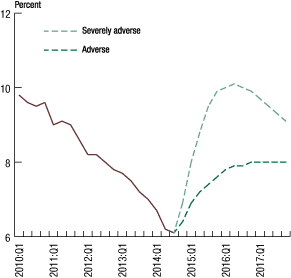
Source: Bureau of Labor Statistics and Federal Reserve assumptions in the supervisory scenarios.
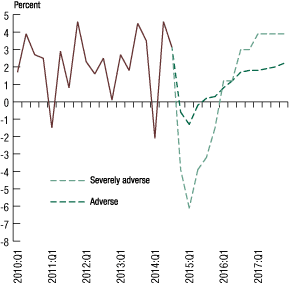
Source: Bureau of Economic Analysis and Federal Reserve assumptions in the supervisory scenarios.
Figure 4. Dow Jones Total Stock Market Index, end of quarter in the severely adverse and adverse scenarios, 2010:Q1-2016:Q4
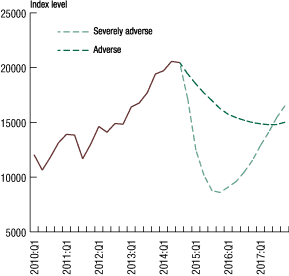
Source: Dow Jones and Federal Reserve assumptions in the supervisory scenarios.
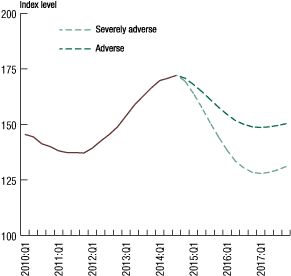
Source: CoreLogic (seasonally adjusted by Federal Reserve) and Federal Reserve assumptions in the supervisory scenarios.
Figure 6. U.S. BBB corporate yield, quarterly average in the severely adverse and adverse scenarios, 2010:Q1-2016:Q4
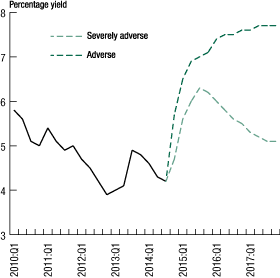
Source: Merrill Lynch (adjusted by Federal Reserve using a Nelson-Siegel smoothed yield curve model) and Federal Reserve assumptions in the supervisory scenarios.
This year's severely adverse scenario is similar to the 2014 severely adverse scenario. However, corporate credit quality is assumed to worsen even more than would be expected in a severe recession, resulting in a greater widening in corporate bond spreads, decline in equity prices, and increase in equity market volatility than in the 2014 severely adverse scenario.
Adverse Scenario
Figures 2 through 7 illustrate the hypothetical trajectories for some of the key variables describing U.S. economic activity and asset prices as well as global economic growth under the adverse scenario. The United States experiences a mild recession that begins in the fourth quarter of 2014 and lasts through the second quarter of 2015. During this period, the level of real GDP falls approximately 0.5 percent relative to its level in the third quarter of 2014, and the unemployment rate increases to just over 7 percent. At the same time, the U.S. economy experiences a considerable rise in core inflation that results in a headline CPI inflation rate of 4 percent by the third quarter of 2015; headline inflation remains elevated thereafter. Short-term interest rates rise quickly as a result, reaching a little over 2.5 percent by the end of 2015 and 5.3 percent by the end of 2017. Longer-term Treasury yields increase by less. The recovery that begins in the second half of 2015 is quite sluggish, and the unemployment rate continues to increase, reaching 8 percent in the fourth quarter of 2016, and flattens thereafter. Equity prices fall both during and after the recession and by the end of the scenario are about 25 percent lower than in the third quarter of 2014. House prices and commercial real estate prices decline by approximately 13 and 16 percent, respectively, relative to their level in the third quarter of 2014.
Outside the United States, the adverse scenario features recessions in the euro area, the United Kingdom, and Japan and below-trend growth in developing Asia. This weakness in economic activity results in a period of deflation for some countries or country blocks. The exchange value of the dollar is little changed vis-à-vis the euro, the pound sterling, and the currencies of developing Asia. The dollar is assumed to depreciate against the yen, reflecting flight-to-safety capital flows.
Figure 7. U.S. Market Volatility Index (VIX) in the severely adverse and adverse scenarios, 2010:Q1-2016:Q4
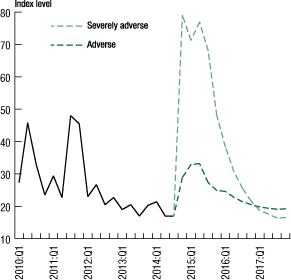
Source: Chicago Board Options Exchange (converted to quarterly by Federal Reserve using the maximum quarterly close-of-day value) and Federal Reserve assumptions in the supervisory scenarios.
This year's adverse scenario is qualitatively different from the 2014 adverse scenario. The main difference lies in the evolution of Treasury yields. The 2014 adverse scenario featured a sharp rise in long-term interest rates not accompanied by an increase in short-term interest rates and hence a steeper yield curve than in the baseline. In this year's scenario the hypothetical pick-up in U.S. inflation results in a yield curve that is higher and flatter than in the baseline.
Global Market Shock and Counterparty Default Components
The Federal Reserve applied a global market shock to the trading portfolio of six BHCs with large trading and private equity exposures.11 In addition, the Federal Reserve applied a counterparty default component, which assumes the default of a BHC's largest counterparty under the global market shock conditions, to the same six BHCs and two other BHCs with substantial trading, processing, or custodial operations.12 These components are an add-on to the macroeconomic conditions and financial market environment specified in the adverse and severely adverse scenarios.
The global market shock is a set of one-time, hypothetical shocks to a broad range of financial market risk factors. Generally, these shocks involve large and sudden changes in asset prices, interest rates, and spreads, reflecting general market dislocation and heightened uncertainty.13 The Federal Reserve published the global market shock for the adverse and severely adverse scenarios on October 30, 2014; the as-of date for the global market shock and the counterparty default is October 6, 2014.
The global market shock for the severely adverse scenario is built around a sudden sharp increase in general risk premiums and credit risk, combined with significant market illiquidity, which is associated in part with the distress of one or more large leveraged entities that rapidly sell a variety of assets into an already fragile market. Under the scenario, severe declines in the value of credit positions have immediate implications for less liquid products. While most declines are comparable to those experienced in 2008, products with favorable current market valuations are assumed to experience greater declines. Notably, option-adjusted spreads on mortgage-backed securities increase significantly.
Globally, government yield curves undergo marked shifts in level and shape due to market participants' risk aversion. The flight to quality pushes rates down across the term structure and appreciates currencies in the United States and certain European countries, while emerging markets and countries that are part of the so-called European periphery experience sharp increases in government yields. Countries that are affected by the flight to quality also experience currency appreciation. Fears of a prolonged and potentially more acute recession in Europe drive up sovereign credit default swap (CDS) spreads in a manner generally consistent with the experience of 2011.
The global market shock component for the adverse scenario is built around market shocks that are, by and large, similar in structure, but not as severe as those assumed in the severely adverse scenario. However, rates across the term structure in the United States and Europe increase, as the flight to quality mainly affects the short end of the yield curve while an aversion to long-term assets prevails. In addition, the increase in implied volatilities for equities is more subdued than what is typically associated with the level of the equity price declines in the adverse scenario.
References
9. See Board of Governors of the Federal Reserve System (2014), "2015 Supervisory Scenarios for Annual Stress Tests Required under the Dodd-Frank Act Stress Testing Rules and the Capital Plan Rule" (Washington: Board of Governors, October 23), www.federalreserve.gov/newsevents/press/bcreg/bcreg20141023a1.pdf for additional information and for the details of the supervisory scenarios. Return to text
10. 12 CFR part 252, appendix A. Return to text
11. The six BHCs subject to the global market shock are Bank of America Corporation; Citigroup Inc.; The Goldman Sachs Group, Inc.; JPMorgan Chase & Co.; Morgan Stanley; and Wells Fargo & Co. See 12 CFR 252.54(b)(2)(i). Return to text
12. The eight BHCs subject to the counterparty default component are Bank of America Corporation; The Bank of New York Mellon Corporation; Citigroup Inc.; The Goldman Sachs Group, Inc.; JPMorgan Chase & Co.; Morgan Stanley; State Street Corporation; and Wells Fargo & Co. See 12 CFR 252.54(b)(2)(ii). Return to text
13. See CCAR 2015: Severely Adverse Market Shocks at www.federalreserve.gov/bankinforeg/CCAR-2015-Severely-Adverse-Market-Shocks.xlsx and CCAR 2015: Adverse Market Shocks at www.federalreserve.gov/bankinforeg/CCAR-2015-Adverse-Market-Shocks.xlsx. Return to text
